Heybeliada - Tour Trough the Woods, Monasteries and Çam Limanı
- Details
- Created on 11 April 2013
- Last Updated on 11 April 2013
Monastery of Hagia Triada
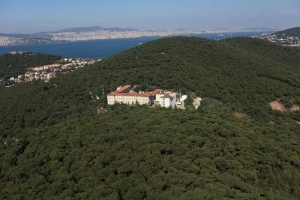 In Byzantine times, there were at least three monasteries on Heybeliada, then known as Halki. The most renowned of these was Hagia Triada, the Holy Trinity, whose site on Ümit Tepesi is occupied by the Greek Orthodox theological school of the same name, a direct descendant of the original Byzantine monastery. The present monastery is the most prominent monument on Heybeliada, dominating the view from an approaching ferry and from within the village itself.
In Byzantine times, there were at least three monasteries on Heybeliada, then known as Halki. The most renowned of these was Hagia Triada, the Holy Trinity, whose site on Ümit Tepesi is occupied by the Greek Orthodox theological school of the same name, a direct descendant of the original Byzantine monastery. The present monastery is the most prominent monument on Heybeliada, dominating the view from an approaching ferry and from within the village itself.
The earliest reference to a monastery on Halki is in the writings of St. Theodore of Studius early in the ninth century. Theodore, abbot of Constantinople’s famous monastery of St. John of Studius, was exiled to a monastery on Halki by Leo V (r. 813-20) because of his criticism of the emperor’s iconoclastic policy. While on Halki, Theodore wrote a number of letters, theological treatises, and poems, one of which was addressed fondly to the monastic cell in which he was confined.
The monastery of the Holy Trinity was restored by the patriarch Photius I (r. 858-67, 877-86), who was twice exiled there, first between his two terms as patriarch and then in the years 887-90. Photius died in the monastery in 890 and was buried there; he was subsequently canonized and is today revered as the patron saint of the Theological School of the Holy Trinity.
The monastery was apparently destroyed at the time of the Turkish Conquest in 1453, moving one anonymous chronicler to lament the loss of what "had earlier been a place where wisdom and knowledge were studied, not only by monks but also by kings and noblemen." In 1550 the monastery was rebuilt or at least partially restored by the future patriarch Metrophanes III (r. 1565-72, 1579-80). Metrophanes also gave to the monastery some three hundred manuscripts, a priceless gift that formed the nucleus of what was to become one of the most renowned libraries in the Orthodox world after that of the Patriarchate in Istanbul.
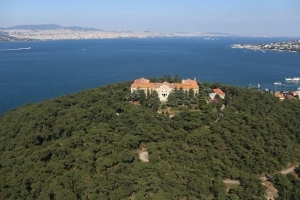 Hagia Triada went through difficult times in the seventeenth and eighteenth centuries, but its finances, at least, improved after Peter the Great, Tsar of Russia (r. 1682-1725), issued a chrysobull giving the monastery a long-term endowment. The monastery was rebuilt and refurbished in 1773 through the efforts of its energetic abbot, Samuel the Deaf. The monastery was badly damaged in 1821, at the beginning of the Greek War of Independence, when it was attacked by a mob and set on fire. The monastery was rebuilt in 1844 by Patriarch Germanos IV, who decreed in a synod that "a theological school should be built for a purpose pleasing to God and dwelt in by theology teachers, priests who wish to learn, and future priests." Wooden buildings were erected to house the classrooms, study hall, teachers’ quarters, student dormitories, refectory, infirmary, and patriarchal apartments, while a two-storey stone structure was built for the library. Then in 1891 a three-storey wing was added to house the administrative offices and new dormitories. All of these structures were seriously damaged in the great earthquake of 1894. Thus a completely new building had to be erected for the monastery, all of the funds for which were provided by the philanthropist Pavlos Skylitsis Stephanovik. The new monastery was designed by the architect Pericles Photiades, and the building was officially dedicated on 6 October 1896, the archimandrite Germanos Gregoras presiding as Rector of the Theological School.
Hagia Triada went through difficult times in the seventeenth and eighteenth centuries, but its finances, at least, improved after Peter the Great, Tsar of Russia (r. 1682-1725), issued a chrysobull giving the monastery a long-term endowment. The monastery was rebuilt and refurbished in 1773 through the efforts of its energetic abbot, Samuel the Deaf. The monastery was badly damaged in 1821, at the beginning of the Greek War of Independence, when it was attacked by a mob and set on fire. The monastery was rebuilt in 1844 by Patriarch Germanos IV, who decreed in a synod that "a theological school should be built for a purpose pleasing to God and dwelt in by theology teachers, priests who wish to learn, and future priests." Wooden buildings were erected to house the classrooms, study hall, teachers’ quarters, student dormitories, refectory, infirmary, and patriarchal apartments, while a two-storey stone structure was built for the library. Then in 1891 a three-storey wing was added to house the administrative offices and new dormitories. All of these structures were seriously damaged in the great earthquake of 1894. Thus a completely new building had to be erected for the monastery, all of the funds for which were provided by the philanthropist Pavlos Skylitsis Stephanovik. The new monastery was designed by the architect Pericles Photiades, and the building was officially dedicated on 6 October 1896, the archimandrite Germanos Gregoras presiding as Rector of the Theological School.
Theological School
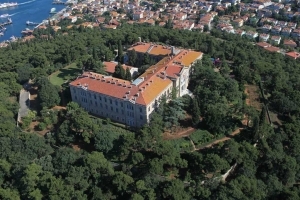 The main entrance to the theological school is a combination of neo-classical and neo-Byzantine styles. Two monoliths of Proconnesian marble crowned with intricately carved Corinthian-type capitals divide the front of the porch, with smaller columns of the same type supporting the stilted arches of the tripartite window above. Four columns identical to those in the porch support the ornately painted ceiling of the entrance hall, from which a pair of marble stairways lead to the great reception hall on the main floor above. The walls of the reception hall are hung with portraits of patriarchs, rectors of the theological school, and others associated with the history of the monastery. At one end of the hall a niche contains the carved wooden iconostasis and its icons from the Byzantine church of the Virgin Kamariotissa on Heybeliada, which was taken over by the Turkish Navy in 1942. The patriarchal apartments, the administrative offices, and the rooms of the faculty are also on the main floor.
The main entrance to the theological school is a combination of neo-classical and neo-Byzantine styles. Two monoliths of Proconnesian marble crowned with intricately carved Corinthian-type capitals divide the front of the porch, with smaller columns of the same type supporting the stilted arches of the tripartite window above. Four columns identical to those in the porch support the ornately painted ceiling of the entrance hall, from which a pair of marble stairways lead to the great reception hall on the main floor above. The walls of the reception hall are hung with portraits of patriarchs, rectors of the theological school, and others associated with the history of the monastery. At one end of the hall a niche contains the carved wooden iconostasis and its icons from the Byzantine church of the Virgin Kamariotissa on Heybeliada, which was taken over by the Turkish Navy in 1942. The patriarchal apartments, the administrative offices, and the rooms of the faculty are also on the main floor.
The classrooms of the school are situated on either side of the transverse corridor on the first floor, and the dormitories of the seminarians are in the north and south wings. The renowned library is also on the first floor as are the refectory, the infirmary, and service facilities such as the barber shop and tailor, while the gymnasium is to the south of the complex. The theological school was closed by the Turkish government in 1971, but political discussions are now under way which, hopefully, will lead to its reopening.
Church of Aya Triada
 The katholikon of the monastery dates from a complete rebuilding in 1843. In plan it is the usual three-aisled basilica with a barrel-vaulted nave and flat ceilings over the side aisles, with the narthex on the west and the main semicircular apse protruding from the east end. The north aisle is named for the renowned icon displaced there—the Blessed Virgin of Consolation—surrounded by scenes from the Twelve Feasts of the Orthodox Church, an important Constantinopolitan work of the fourteenth century. The south aisle is dedicated to the Prophet Elijah, who is depicted in an icon along with fourteen scenes from his life, dated 1772. On the right side of the narthex there is a chapel dedicated to St. John the Evangelist and St. Germanos the Confessor, patriarch of Constantinople in the years 715-30.
The katholikon of the monastery dates from a complete rebuilding in 1843. In plan it is the usual three-aisled basilica with a barrel-vaulted nave and flat ceilings over the side aisles, with the narthex on the west and the main semicircular apse protruding from the east end. The north aisle is named for the renowned icon displaced there—the Blessed Virgin of Consolation—surrounded by scenes from the Twelve Feasts of the Orthodox Church, an important Constantinopolitan work of the fourteenth century. The south aisle is dedicated to the Prophet Elijah, who is depicted in an icon along with fourteen scenes from his life, dated 1772. On the right side of the narthex there is a chapel dedicated to St. John the Evangelist and St. Germanos the Confessor, patriarch of Constantinople in the years 715-30.
The carved wooden iconostasis is richly decorated with floral, faunal, and heraldic motifs in perforated relief, as are the episcopal throne, the pulpit and the Oraia Pylai, or Beautiful Gates, in the center of the screen. Flanking the Oraia Pylai are icons of Christ Pantocrator, on the right, and the Virgin Hodigitria, on the left, the latter a work of the Cretan School dating from the sixteenth century. The icon of St. John the Baptist, with twelve scenes from his life, is probably also from the sixteenth century. Beneath it is the Hospitality of Abraham, which may date from the fifteenth century. Also on the iconostasis is a large icon depicting St. Photius, patron saint of the school, with an intricately worked silver covering done in Moscow in 1903. On the southern wall there is a large icon of the Virgin Hodigitria, possibly dating from the sixteenth century. Also noteworthy are the icon stands and candle stand in the narthex, all finely carved in wood with floral and heraldic motifs.
There are a number of tombs behind the church, including those of rectors and professors of the school as well as two patriarchs, Cyril VII (r. 1855-60) and Constantine V. (r. 1897-1901)
The monastery of St. John the Baptist (Hagios Ioannis Prodromos)
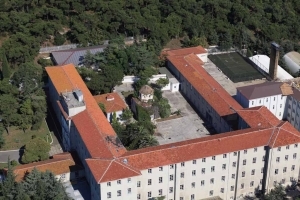 The monastery of St. John the Baptist (Hagios Ioannis Prodromos) was in the center of the island, on the western slope of Değirmen Tepesi. The site is now within grounds belonging to the Turkish Naval High School, and can be visited only with special permission from the commandant.
The monastery of St. John the Baptist (Hagios Ioannis Prodromos) was in the center of the island, on the western slope of Değirmen Tepesi. The site is now within grounds belonging to the Turkish Naval High School, and can be visited only with special permission from the commandant.
The founding date of the original monastery is not known, but it was probably built in the medieval Byzantine period. The monastery was destroyed in 1672, and all that survived was a chapel dedicated to the Virgin Theotokos, the Mother of God, also known as the Kamariotissa, Our Lady of the Arches. The monastery and chapel were rebuilt the following year by Nikosios Paniotakis, who was the Grand Vizier’s dragoman, or chief interpreter. Thenceforth the establishment was known as the monastery of the Panagia Kamariotissa.
In 1828, during the Russo-Turkish War, the monastery was used to house Russian prisoners of war, some three hundred of whom died here. A memorial to them, a (now headless) statue of an angel holding the czars’ coat of arms, a double-headed eagle, can be seen in a small fenced area on the road just above (Aşıklar Yolu, or Lovers’ Lane, cutting across the middle of the island). The Greek Commercial School (Emporikis Scholis) was founded at the monastery in 1831, and in 1875 a new five-storey building was added, making it possible to accommodate some four hundred students, who came from all over the Greek world. The school closed during World War I, when its buildings were requisitioned by the Turkish government. After the war the school reverted to the Orthodox Patriarchate, which used it to house Greek orphans from Anatolia who were displaced in the population exchange of 1923. Then in 1942 the monastery was expropriated by the Turkish government to house part of the Naval Academy. The iconostasis and icons of the Kamariotissa were then transferred to the monastery of the Holy Trinity and the Patriarchate, while the church itself was abandoned and left desolate, as it remains today.
The monastery of St. George (Hagios Georgios tou Kremnou)
The monastery of St. George (Hagios Georgios tou Kremnou) is a pink complex on the shore south of the village, just beyond the Navy’s ordu evi (officers’ club). The appellation "tou Kremnou," or "on the cliff," stems from the fact that it is built on a bluff above the sea. The setting is quite beautiful, with pines, cypresses and other trees embowering the picturesque buildings of the monastery above the blue Marmara, a scene reminiscent of the Aegean isles of Greece.
The monastery is believed to have been founded in the years 1583-93. The Reverend John Covel visited the monastery in 1677. As he notes in his diary for 26 February of that year: "There is another monastery here, dedicated to St. George. It is decimated and under [the metopolitan of] Chalcedon. There are bookes there too, but I judging they were much of the same stuff, did not take the paines of seeing it." The English traveller Richard Pococke, who visited the island in 1739, remarked that Greeks from Istanbul took refuge in the monastery of St. George during times of plague.
The patriarch Ioannikos (r. 1761-3) retired to the monastery of St. George after his term of office in the Patriarchate. He had already built a new katholikon in the monastery, dedicating it in memory of his father, Georgios Karatzas, according to an inscription set into the wall. Ioannikos also founded a "school for mutual instruction" dedicated to the Holy Sepulchre of Jerusalem, making the monastery a metochion of the Patriarchate of Jerusalem, as it remains today.
The katholikon was damaged by a fire in 1882, which destroyed the old wooden iconostasis and all of its icons, as well as the liturgical furniture. Most of the icons that one sees now in the church are modern Russian works. The only notable icon of earlier date is in the narthex. This is an icon of St. George painted in 1764 by an anonymous monk and dedicated to the patriarch Ioannikos, who is buried in the narthex.
Süslü Mezar
There is another tomb on the grounds just below the road that leads past the monastery. This is the 1868 mausoleum of the wife of the noted eccentric Spyridon Kanglaris; when he died, he was buried next to this monument. This octagonal brick structure with open ogive arches is screened by wrought iron gratings. On the hillside below it there is a marble wellhead commissioned in 1910 by the abbot Procopius Arapoğlu. Water is still drawn from the cistern beneath.
Turkish Cemeteries
A short distance beyond the monastery a road leads off half-right from the coast road to the Muslim Turkish and Orthodox Greek cemeteries. The oldest funerary monuments in the Turkish cemetery can be distinguished by the stone turbans that top the tombstones, for the turban was banned in 1826 in favor of the fez, which was in turn banned in 1925. Among the notables buried here are Hacı Ahmet Hulusi Paşa, one of the last Ottoman governors of Salonica, and Lütfi Müfit Özdes, a comrade-in-arms of Atatürk.
The Greek cemetery has a neo-classical chapel dedicated to St. Barbara (Hagia Barbara).
The monastery of Hagios Spyridon
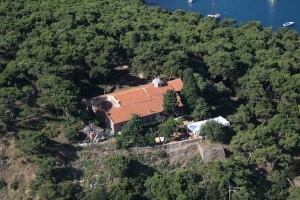 The monastery of Hagios Spyridon (called Terki Dunya in Turkish) is on the southwest coast of the island, perched on the promontory that forms the western horn of the huge crescent-shaped bay known as Çam Limanı (Pine Port). This little monastery began in 1868 as a skete, a simple monastic hut, dedicated to St. Spyridon by a young monk from Thrace known as Arsenios. Subsequently the metropolitan bishop of Cephalonia, Embariki Mazarakis, helped Arsenios build the katholikon and a small dormitory for the monks. The monastery was destroyed in the 1894 earthquake, but then rebuilt to twice its original size. When Father Arsenios died in 1905 he was buried in the garden of his monastery. The monastery was restored in 1954 by Patriarch Athenagoras. It has since been badly damaged by fire and is now falling into ruins.
The monastery of Hagios Spyridon (called Terki Dunya in Turkish) is on the southwest coast of the island, perched on the promontory that forms the western horn of the huge crescent-shaped bay known as Çam Limanı (Pine Port). This little monastery began in 1868 as a skete, a simple monastic hut, dedicated to St. Spyridon by a young monk from Thrace known as Arsenios. Subsequently the metropolitan bishop of Cephalonia, Embariki Mazarakis, helped Arsenios build the katholikon and a small dormitory for the monks. The monastery was destroyed in the 1894 earthquake, but then rebuilt to twice its original size. When Father Arsenios died in 1905 he was buried in the garden of his monastery. The monastery was restored in 1954 by Patriarch Athenagoras. It has since been badly damaged by fire and is now falling into ruins.
The Monastery of the Metamorphosis of Christ the Saviour
 There is another small monastery on the peak of Baltacıoglu Tepesi at the southwestern end of the island. This also originated as a skete, founded in 1835 by a monk named Andonis Tsimas. The skete eventually developed into the monastery of the Metamorphosis of Christ the Saviour (Metamorphoseos tou Sotiros Christou), known in Turkish variously as Hristos Manastir (Christ Monastery) or Makarios Monastery, in memory of a monk of that name. All that remains today is a small chapel and an attached house, both embowered in a picturesque setting on the hilltop.
There is another small monastery on the peak of Baltacıoglu Tepesi at the southwestern end of the island. This also originated as a skete, founded in 1835 by a monk named Andonis Tsimas. The skete eventually developed into the monastery of the Metamorphosis of Christ the Saviour (Metamorphoseos tou Sotiros Christou), known in Turkish variously as Hristos Manastir (Christ Monastery) or Makarios Monastery, in memory of a monk of that name. All that remains today is a small chapel and an attached house, both embowered in a picturesque setting on the hilltop.
The Heybeliada Sanitarium
The Heybeliada Sanitarium is perched on a bluff above the sea on Yeşıl Burnu (Green Point), the promontory that forms the eastern arm of Çam Limanı. Founded in 1924 under the direction of Professor Dr. Sever Kamil, it was the first sanitarium in Istanbul, and presently closed
Çam Limanı
 Çam Limanı is a well-known summer destination for visitors wanting to swim and to picnic beside the sea under the pine trees. In earlier times there were cafes along the water, but today the bay has fallen on hard times and consists of a rough beach, some little snack and soft-drink stands, and a football field. Still, Istanbulites all know the song by Yesari Asim Arsoy (whose statue is mentioned above) that celebrates the pleasures of an earlier era’s moonlight evenings at Çam Limanı.
Çam Limanı is a well-known summer destination for visitors wanting to swim and to picnic beside the sea under the pine trees. In earlier times there were cafes along the water, but today the bay has fallen on hard times and consists of a rough beach, some little snack and soft-drink stands, and a football field. Still, Istanbulites all know the song by Yesari Asim Arsoy (whose statue is mentioned above) that celebrates the pleasures of an earlier era’s moonlight evenings at Çam Limanı.
The Heybeliada Water Sports Club
The Heybeliada Water Sports Club (Su Sporları Klübü) is on Değırmen Burnu, the northwestern promontory of the island. The promontory takes its name from a windmill (in Turkish, değirmen), which appears as a landmark in all views of the island going back to Ottoman times.
The Merit Halki Palas
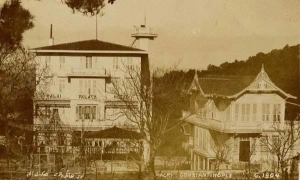 The Merit Halki Palas Hotel is on the hillside above the large bay that indents the northwestern shore of the island. The original hotel on this site was built in the years 1852-62, most of its clients being the parents of students at the Greek Commercial School. The hotel was destroyed by fire in 1991, but it was rebuilt in 1992 in its original elegant 19th century style, but with the addition of modern conveniences such as a swimming pool and gymnasium. The Halki Palas is ideally situated for those who would like to explore Heybeliada on foot, particularly along the pine-scented roads in the uninhabited southwestern end of the island.
The Merit Halki Palas Hotel is on the hillside above the large bay that indents the northwestern shore of the island. The original hotel on this site was built in the years 1852-62, most of its clients being the parents of students at the Greek Commercial School. The hotel was destroyed by fire in 1991, but it was rebuilt in 1992 in its original elegant 19th century style, but with the addition of modern conveniences such as a swimming pool and gymnasium. The Halki Palas is ideally situated for those who would like to explore Heybeliada on foot, particularly along the pine-scented roads in the uninhabited southwestern end of the island.
Abbas Hilmi’s Palace
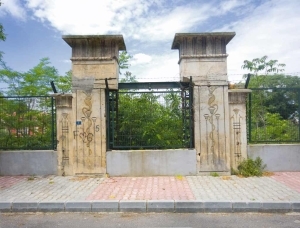 At #5 Abbas Paşa Sokağı there remains only the crumbling wall that surrounded the palace; on this wall the visitor can see an Egyptian lotus motif incised in the pillars. The nearby houses at #7 and #9 Fettah Sokağı served as the selamlık, or men’s quarters, of Abbas Hilmi’s palace.
At #5 Abbas Paşa Sokağı there remains only the crumbling wall that surrounded the palace; on this wall the visitor can see an Egyptian lotus motif incised in the pillars. The nearby houses at #7 and #9 Fettah Sokağı served as the selamlık, or men’s quarters, of Abbas Hilmi’s palace.
Hüseyin Rahmi Evi
 Hüseyin Rahmi Gürpınar (1864-1944), the renowned journalist, essayist and novelist. This is now a museum containing many interesting mementos of the writer’s life, as well as period furniture, pictures and other objects.
Hüseyin Rahmi Gürpınar (1864-1944), the renowned journalist, essayist and novelist. This is now a museum containing many interesting mementos of the writer’s life, as well as period furniture, pictures and other objects.



